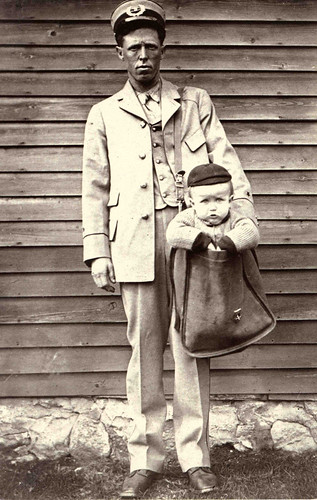Since the Smithsonian began uploading photos to the Flickr Commons, there have been some clear crowd favorites. The photo above, for example, is by far our most popular photo on the Flickr Commons, with over 42,000 views and 950 favorites since it was uploaded about a year ago. We decided that it might be worth highlighting some of these popular Commons photographs as a way of delving deeper into our collections and perhaps answering some of the questions about these photos posed by Flickr users.
Clearly, many were startled and amazed by this photo of a postal carrier with a child in his mail bag, and so for some clarification, I spoke to Nancy Pope, historian at the National Postal Museum. She reiterated the information from the Flickr caption for this photograph: first, that this photo was actually a staged piece, and second, that there is little evidence that babies were sent through the mail other than in two known cases in which children were placed on train cars as "freight mail" as this was cheaper than buying them a regular train ticket.
While it is certain that sending babies through the mail was not commonplace, I did find a small sampling of articles on the subject in New York Times from 1913-14. One of these articles, titled "BABY BOY BY PARCEL POST: Rural Carrier Safely Delivered 10 ¾ Pound Infant to Grandmother," tells the story of how mail carrier Vernon Lytle delivered a baby, "well wrapped and ready for ‘mailing,’" from his parents’ to his grandmother’s house, a mile down the road. Perhaps tongue in cheek, the author ends, "The postage was fifteen cents and the parcel was insured for $50." Just a year later, the Times wrote another article about a two-year-old baby who was delivered from his grandmother’s home to his aunt’s home twenty-three miles away. Finally, and in a more heartbreaking instance, the Times printed an article regarding a recent letter to the Postmaster General from a family wishing to adopt a baby located in Georgia—they inquired about the proper specifications for wrapping a baby so that they could receive a youngster by mail at their home in Pennsylvania.
However the services may have been (mis)interpreted during this era, these stories point out that mail service was particularly important during a time when travel was difficult and cost-prohibitive for many Americans. But perhaps more interestingly, they indicate that the mail carrier was considered a crucial part of communities—a touchstone with family and friends far away from each other, a bearer of important news and goods. In some ways, Americans trusted their postmen with their lives (and in the cases mentioned above, with their babies!).
View more photos from the National Postal Museum.
Produced by the Smithsonian Institution Archives. For copyright questions, please see the Terms of Use.


Leave a Comment